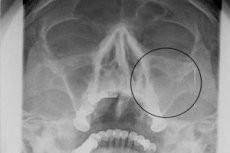Medical expert of the article
New publications
Acute sinusitis - Diagnosis
Last reviewed: 04.07.2025

All iLive content is medically reviewed or fact checked to ensure as much factual accuracy as possible.
We have strict sourcing guidelines and only link to reputable media sites, academic research institutions and, whenever possible, medically peer reviewed studies. Note that the numbers in parentheses ([1], [2], etc.) are clickable links to these studies.
If you feel that any of our content is inaccurate, out-of-date, or otherwise questionable, please select it and press Ctrl + Enter.

Physiological examination
Of great importance in detecting sinusitis is the sequential performance of anterior, middle and posterior rhinoscopy. Rhinoscopic signs of sinusitis include: discharge in the nasal passages, hyperemia, edema and hyperplasia of the mucous membrane.
Pathological discharge in the middle nasal passage (anterior rhinoscopy), as a rule, indicates a possible lesion of the frontal and maxillary sinuses, anterior and middle cells of the ethmoid labyrinth, in the superior nasal passage (posterior rhinoscopy) - a possible lesion of the posterior cells of the ethmoid labyrinth and sphenoid sinus. However, the absence of pathological discharge in the nasal cavity does not exclude a disease of the sinuses. In particular, there may be no discharge (periodically or constantly) if the patency of the junction of the affected sinuses with the nasal cavity is impaired or if the discharge is highly viscous.
Laboratory research
A clinical blood test confirms the presence of an inflammatory process and indirectly characterizes its intensity (ESR, number of leukocytes, ratio of different forms of leukocytes).
Microbiological studies of the puncture allow to identify the pathogen and determine its sensitivity to various antibiotics. Unfortunately, in acute sinusitis, the data of microbiological studies can be obtained only on the 3rd-4th day from the onset of the disease and lose their relevance when prescribing empirical therapy.
Instrumental research
To clarify the diagnosis and determine the nature and extent of damage to the paranasal sinuses, special research methods are used: radiography and diagnostic puncture of the sinuses.
X-ray methods of examining the paranasal sinuses are among the most common methods in diagnosing sinusitis, which allow us to judge the presence or absence of sinuses, their shape, size, as well as the nature and localization of the pathological process. A X-ray sign of sinusitis is considered to be a decrease in pneumatization of the paranasal sinuses, sometimes a horizontal level of exudate can be seen on the X-ray.
To clarify the degree and nature of damage to the paranasal sinuses, it is advisable to conduct studies in several projections. The most common are direct projections (frontal-nasal, naso-mental) and lateral.
When assessing the degree of pneumatization of the paranasal sinuses, it is customary to compare the diseased and healthy sides. However, this method cannot be used in polysinusitis. In this regard, when reading radiographs, a comparison is made between the pneumatization of the sinuses and the fairly stable transparency of the orbit.
Puncture of the paranasal sinuses for both diagnostic and therapeutic purposes has found wide application in practice. Currently, the most common puncture is of the maxillary sinus through the inferior nasal passage.
Among the new auxiliary means of diagnosing diseases of the paranasal sinuses, it is worth noting thermography, diagnostics using pulsed ultrasound, thermal imaging, CT, and MRI.
Summarizing the variety of diagnostic methods, it is necessary to highlight the main methods that ensure correct, timely diagnostics of sinusitis. Recognition of the disease largely depends on the correct clinical examination of the patient. In particular, fully collected complaints and anamnesis, rational assessment of the data of anterior, middle and posterior rhinoscopy, objective interpretation of radiography data, sinus puncture are necessary. Clinical analysis of the results of such examination allows in the overwhelming majority of cases to establish or reject the diagnosis of sinusitis and determine its form.
Differential diagnosis of acute sinusitis
Differential diagnostics of acute sinusitis is carried out with neuralgia of the trigeminal nerve (middle and upper branches), paresthesia, pathology of the teeth of the upper jaw, headaches of various etiologies (hypertension, vascular spasms, etc.).


 [
[